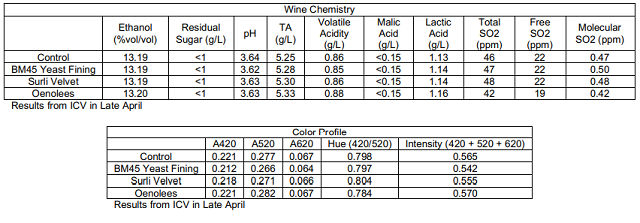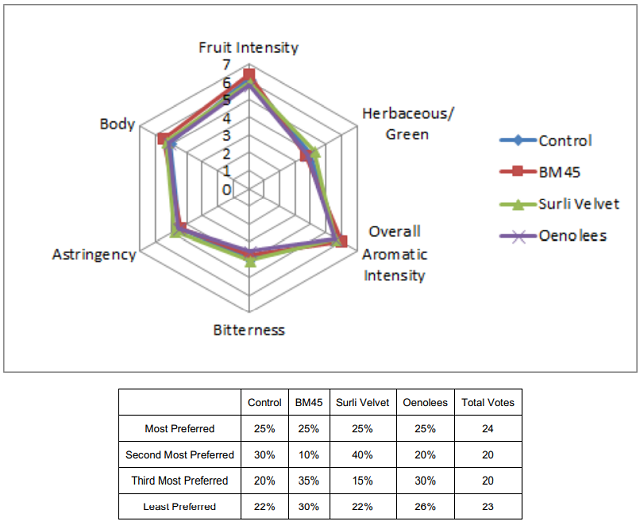The Impact of Yeast Fining on Wine Quality Prior to Bottling (Enartis, Laffort) (2017)
Tim Gorman
Cardinal Point Winery
Summary
This study examines the impact of different yeast fining techniques on finished wine quality. A 2017 red wine blend (75% Cabernet Franc, 25% Petit Verdot) was blended into tank in early February. Then, on February 8 the wine was split into four analogous neutral barrels, and the barrels either received no treatment (control), a BM45 yeast addition at 1g/L, a Surli Velvet (Enartis) addition at 0.05g/L, or an Oenolees (Laffort) addition at 0.4g/L. The barrels were stirred on the date of addition and a week later. The wine was pulled for analysis and bottle samples on March 15. There were no differences in wine chemistry and color. For the descriptive analysis, there were no strong trends for the descriptors used in this study. There was a slight tendency for the BM45 treatment to have higher Fruit Intensity, Overall Aromatic Intensity, and Body and lower Herbaceous/Green character. Oenolees had a slight tendency for lower Fruit Intensity and Bitterness. Surli Velvet had a slight tendency towards higher Herbaceous/Green character and Astringency. Many of these differences were not very pronounced, however, and many judges commented that differences were slight. All wines were equally preferred, more or less. Some judges remarked that the BM45 treatment seemed to have a larger effect on the mouthfeel than the rest. More studies are needed in order to better quantify the impacts of these treatments on wine flavor and aroma quality.
Introduction
Adding yeast or yeast cell wall polysaccharides may help to reduce bitterness and astringency in finished wine, as well as contribute to an increased perception of mouthfeel (Laffort 2018; Enartis 2018). This study examined the impact of adding BM45 yeast at 1/gL (approximately $0.12 per Liter), Surli Velvet (Enartis) addition at 0.05g/L (approximately $0.032 per Liter), or Oenolees (Laffort) addition at 0.4g/L (approximately $0.023 per Liter) on the chemistry and mouthfeel of a resulting red wine blend.
Results and Discussion
There were no differences in wine chemistry and color. For the descriptive analysis, there were no strong trends for the descriptors used in this study. There was a slight tendency for the BM45 treatment to have higher Fruit Intensity, Overall Aromatic Intensity, and Body and lower Herbaceous/Green character. Oenolees had a slight tendency for lower Fruit Intensity and Bitterness. Surli Velvet had a slight tendency towards higher Herbaceous/Green character and Astringency. Many of these differences were not very pronounced, however, and many judges commented that differences were slight. All wines were equally preferred, more or less. Some judges remarked that the BM45 treatment seemed to have a larger effect on the mouthfeel than the rest. More studies are needed in order to better quantify the impacts of these treatments on wine flavor and aroma quality.


Methods
A 2017 red wine (75% Cabernet Franc, 25% Petit Verdot blend) was blended into tank in early February 2018. On February 8, four analogous neutral barrels were filled with this wine. Then the following treatments were performed on each barrel:
- Control (No product)
- BM45 Addition (1g/L) (approximately $0.12 per Liter)
- Surli Velvet (Enartis) Addition (0.05g/L) (approximately $0.032 per Liter)
- Oenolees (Laffort) Addition (0.4g/L) (approximately $0.023 per Liter)
Pricing was researched on May 3, 2018. Each barrel was then stirred for 40 strokes on February 8, after additions were made. They were again stirred for 40 strokes on February 15. No further intervention occurred until wine was pulled for WRE on March 15. Although this winery generally only fines for two weeks before bottling, one of the products required 4 weeks, so that is how long all products were tried for.
This wine was tasted on May 2. In order to balance the data set to perform statistical analysis for descriptive analysis, any judge who had not fully completed the descriptive analysis ratings were removed. In order to then make the number of judges between groups equivalent, one judge from group 2 eliminated. This resulted in a final data set of 3 groups, each with 7 judges (considered as replications within groups, and groups were considered as assessors). Data was analyzed using Panel Check V1.4.2. Because this is not a truly statistical set-up, any results which are found to be statistically significant (p<0.05) will be denoted as a “strong trend” or a “strong tendency,” as opposed to general trends or tendencies. The statistical significance here will ignore any other significant effects or interactions which may confound the results (such as a statistically significant interaction of Judge x Wine confounding a significant result from Wine alone). The descriptors used in this study were Fruit Intensity, Herbaceous/Green, Overall Aromatic Intensity, Bitterness, Astringency, and Body.
References
Laffort. Oenolees. Accessed May 14, 2018. https://www.laffort.com/images/stories/telechargement/fiches%20commerciales/2%20-%20FC%20-%20ANGLAIS/FP_EN_Oenolees.pdf
Enartis. Surli Velvet. Accessed May 14, 2018. http://shop-usa.enartis.com/surli-velvet
